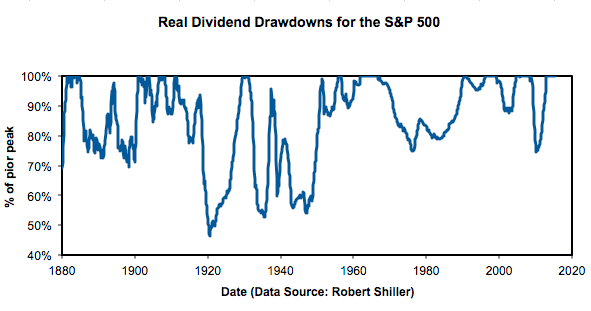Dividend income doesn’t last forever
Dividend stocks aren't immune from downturns
Advertisement
Dividend stocks aren't immune from downturns
 Dividend investors suffered from a much longer down period during the 1970s and 1980s. The S&P 500’s real dividend peaked in 1966, slipped to about 75% of its former high, and didn’t fully recover until 1990. Those living on their dividends in 1966 would have had to cut back for the next quarter of a century.
In addition, there were some giant downturns in the more distant past when real dividends fell below 60% of their former highs.
As a result, retirees who want to live on their dividends, without selling any shares, would be wise to avoid depending on all of their dividend income. For instance, they might live on 75% of their peak dividend income instead.
Mind you, if you take such a conservative approach, you’ll likely end up leaving a large estate to your heirs. If you want to die broke–or nearly so–then you don’t need to be quite so cautious.
Dividend investors suffered from a much longer down period during the 1970s and 1980s. The S&P 500’s real dividend peaked in 1966, slipped to about 75% of its former high, and didn’t fully recover until 1990. Those living on their dividends in 1966 would have had to cut back for the next quarter of a century.
In addition, there were some giant downturns in the more distant past when real dividends fell below 60% of their former highs.
As a result, retirees who want to live on their dividends, without selling any shares, would be wise to avoid depending on all of their dividend income. For instance, they might live on 75% of their peak dividend income instead.
Mind you, if you take such a conservative approach, you’ll likely end up leaving a large estate to your heirs. If you want to die broke–or nearly so–then you don’t need to be quite so cautious.
| Name | Price | P/B | P/E | Earnings Yield | Dividend Yield |
|---|---|---|---|---|---|
| Potash Corp (POT) | $37.07 | 2.73 | 17.33 | 5.77% | 5.32% |
| BCE (BCE) | $53.51 | 4.09 | 18.98 | 5.27% | 4.86% |
| CIBC (CM) | $91.15 | 1.94 | 10.38 | 9.63% | 4.78% |
| National Bank (NA) | $45.55 | 1.69 | 10.14 | 9.86% | 4.57% |
| Bank of Montreal (BMO) | $74.20 | 1.44 | 11.95 | 8.37% | 4.42% |
| Shaw (SJR.B) | $27.13 | 2.62 | 16.75 | 5.97% | 4.37% |
| Rogers (RCI.B) | $44.25 | 4.19 | 17.63 | 5.67% | 4.34% |
| Bank of Nova Scotia (BNS) | $63.21 | 1.64 | 10.99 | 9.10% | 4.30% |
| TransCanada (TRP) | $50.23 | 2.1 | 20.67 | 4.84% | 4.14% |
| Royal Bank (RY) | $76.62 | 2.13 | 11.79 | 8.48% | 4.02% |
Share this article Share on Facebook Share on Twitter Share on Linkedin Share on Reddit Share on Email